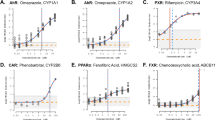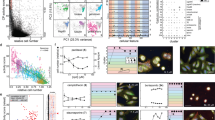Abstract
This protocol describes how to use cytochrome P450–dependent monooxygenase (CYP)-expressing cell lines in toxicity testing of chemicals in vitro. Selected cells amenable to permanently grow in culture are genetically manipulated to stably express single CYP enzymes originating from any species of interest. This expression can be characterized by, for example, determining CYP mRNA content, CYP protein level (western blotting or in situ immunofluorescence) and CYP-mediated enzyme activity (substrate conversion assays). These cells can be used to determine substrate specificities and species differences, e.g., in the bioactivation of drugs. Once constructed, CYP-expressing cells can serve as a straightforward and reliable tool in toxicity testing and the corresponding assays could be adapted for high-throughput analysis. Using these cells, enzyme assays can be performed in a matter of hours. This protocol is exemplified with V79 fibroblasts from Chinese hamster (Cricetulus griseus), modified to express human cytochrome P450 1B1 (CYP1B1). These cells are characterized for their CYP1B1-linked properties by in situ immunofluorescence and their activity in the 7-ethoxyresorufin-O-deethylase enzyme assay. This is followed by an assay showing metabolic activation of the polycyclic aromatic hydrocarbon dibenzo[a,l]pyrene by CYP1B1, along with the toxicological endpoints of cytotoxicity and micronucleus formation.
This is a preview of subscription content, access via your institution
Access options
Subscribe to this journal
Receive 12 print issues and online access
$259.00 per year
only $21.58 per issue
Buy this article
- Purchase on Springer Link
- Instant access to full article PDF
Prices may be subject to local taxes which are calculated during checkout




Similar content being viewed by others
References
Contopoulos-Ioannidis, D.G., Alexiou, G.A., Gouvias, T.C. & Ioannidis, J.P. Medicine. Life cycle of translational research for medical interventions. Science 321, 1298–1299 (2008).
Schoonen, W.G., Westerink, W.M. & Horbach, G.J. High-throughput screening for analysis of in vitro toxicity. In Molecular, Clinical and Environmental Toxicology Vol. 1 (ed. Luch, A.) 401–452 (Birkhäuser Publishing, Switzerland, 2009).
Smith, D.A. & Schmid, E.F. Drug withdrawals and the lessons within. Curr. Opin. Drug Discov. Devel. 9, 38–46 (2006).
Guengerich, F.P. Cytochrome P450s and other enzymes in drug metabolism and toxicity. AAPS J. 8, E101–111 (2006).
Dekant, W. The role of biotransformation and bioactivation in toxicity. In Molecular, Clinical and Environmental Toxicology Vol. 1 (ed. Luch, A.) 57–86 (Birkhäuser Publishing, Switzerland, 2009).
Hart, S.N. & Zhong, X.B. P450 oxidoreductase: genetic polymorphisms and implications for drug metabolism and toxicity. Expert Opin. Drug Metab. Toxicol. 4, 439–452 (2008).
Nebert, D.W. & Dalton, T.P. The role of cytochrome P450 enzymes in endogenous signalling pathways and environmental carcinogenesis. Nat. Rev. Cancer 6, 947–960 (2006).
Guengerich, F.P. Cytochrome P450 and chemical toxicology. Chem. Res. Toxicol. 21, 70–83 (2008).
Nelson, D.R. et al. Comparison of cytochrome P450 (CYP) genes from the mouse and human genomes, including nomenclature recommendations for genes, pseudogenes and alternative-splice variants. Pharmacogenetics 14, 1–18 (2004).
Ingelman-Sundberg, M. Pharmacogenetics of cytochrome P450 and its applications in drug therapy: the past, present and future. Trends Pharmacol. Sci. 25, 193–200 (2004).
Luch, A. Nature and nurture—lessons from chemical carcinogenesis. Nat. Rev. Cancer 5, 113–125 (2005).
Doehmer, J. et al. Cytochrome P450 mediated reactions studied in genetically engineered V79 Chinese hamster cells. Pharmacogenetics 5, S91–96 (1995).
Schober, W. et al. On the species-specific biotransformation of dibenzo[a,l]pyrene. Chem. Biol. Interact. 161, 37–48 (2006).
Doehmer, J. et al. Building a biotechnology platform for metabolism studies in pharmacology and toxicology. In Progress in the Reduction, Refinement and Replacement of Animal Experimentation (eds. Balls, M., van Zeller, A.M. & Halders, M.E.) 139–146 (Elsevier Science, 2000).
Parikh, A., Gillam, E.M. & Guengerich, F.P. Drug metabolism by Escherichia coli expressing human cytochromes P450. Nat. Biotechnol. 15, 784–788 (1997).
Pritchard, M.P., McLaughlin, L. & Friedberg, T. Establishment of functional human cytochrome P450 monooxygenase systems in Escherichia coli. Methods Mol. Biol. 320, 19–29 (2006).
Luch, A. et al. Stable expression of human cytochrome P450 1B1 in V79 Chinese hamster cells and metabolically catalyzed DNA adduct formation of dibenzo[a,l]pyrene. Chem. Res. Toxicol. 11, 686–695 (1998).
Luch, A. et al. Metabolic activation of dibenzo[a,l]pyrene by human cytochrome P450 1A1 and P450 1B1 expressed in V79 Chinese hamster cells. Chem. Res. Toxicol. 12, 353–364 (1999).
Krahn, D.F. Chinese hamster cell mutagenesis: a comparison of the CHO and V79 systems. Ann. NY Acad. Sci. 407, 231–238 (1983).
Liu, Y. & Glatt, H. Human cytochrome P450 2E1 and sulfotransferase 1A1 coexpressed in Chinese hamster V79 cells enhance spontaneous mutagenesis. Environ. Mol. Mutagen. 51, 23–30 (2010).
Teubner, W., Meinl, W. & Glatt, H. Stable expression of rat sulfotransferase 1B1 in V79 cells: activation of benzylic alcohols to mutagens. Carcinogenesis 23, 1877–1884 (2002).
Luch, A. et al. The K-region trans-8,9-diol does not significantly contribute as an intermediate in the metabolic activation of dibenzo[a,l]pyrene to DNA-binding metabolites by human cytochrome P450 1A1 or 1B1. Cancer Res. 59, 4603–4609 (1999).
Doehmer, J. Predicting drug metabolism-dependent toxicity for humans with a genetically engineered cell battery. Altern. Lab. Anim. 34, 561–575 (2006).
Coecke, S. et al. Metabolism: a bottleneck in in vitro toxicological test development. The report and recommendations of ECVAM workshop 54. Altern. Lab. Anim. 34, 49–84 (2006).
Borenfreund, E. & Puerner, J.A. A simple quantitative procedure using monolayer culture for toxicity assays. J. Tissue Cult. Meth. 9, 7–9 (1984).
Ralston, S.L., Seidel, A., Luch, A., Platt, K.L. & Baird, W.M. Stereoselective activation of dibenzo[a,l]pyrene to (−)-anti(11R,12S,13S,14R)- and (+)-syn(11S,12R,13S,14R)-11,12-diol-13,14-epoxides which bind extensively to deoxyadenosine residues of DNA in the human mammary carcinoma cell line MCF-7. Carcinogenesis 16, 2899–2907 (1995).
Phillips, D.H. & Arlt, V.M. The 32P-postlabeling assay for DNA adducts. Nat. Protoc. 2, 2772–2781 (2007).
Seidel, A. et al. Regio- and stereoselectivity in the metabolism of benzo[c]phenanthrene mediated by genetically engineered V79 Chinese hamster cells expressing rat and human cytochromes P450. Environ. Toxicol. Pharmacol. 5, 179–196 (1998).
Luch, A., Glatt, H., Platt, K.L., Oesch, F. & Seidel, A. Synthesis and mutagenicity of the diastereomeric fjord-region 11,12-dihydrodiol 13,14-epoxides of dibenzo[a,l]pyrene. Carcinogenesis 15, 2507–2516 (1994).
Luch, A., Seidel, A., Glatt, H. & Platt, K.L. Metabolic activation of the (+)-S,S- and (−)-R,R-enantiomers of trans-11,12-dihydroxy-11,12-dihydro-dibenzo[a,l]pyrene: stereoselectivity, DNA adduct formation, and mutagenicity in Chinese hamster V79 cells. Chem. Res. Toxicol. 10, 1161–1170 (1997).
Sutter, T.R. et al. Complete cDNA sequence of a human dioxin-inducible mRNA identifies a new gene subfamily of cytochrome P450 that maps to chromosome 2. J. Biol. Chem. 269, 13092–13099 (1994).
Schneider, A. et al. Stable expression of human cytochrome P450 3A4 in conjunction with human NADPH-cytochrome P450 oxidoreductase in V79 Chinese hamster cells. Arch. Biochem. Biophys. 332, 295–304 (1996).
Ford, D.K. & Yerganian, G. Observations on the chromosomes of Chinese hamster cells in tissue culture. J. Natl. Cancer Inst. 21, 393–425 (1958).
Graham, F.L. & van der Eb, A.J. A new technique for the assay of infectivity of human adenovirus 5 DNA. Virology 52, 456–467 (1973).
Doehmer, J. et al. Stable expression of rat cytochrome P-450IIB1 cDNA in Chinese hamster cells (V79) and metabolic activation of aflatoxin B1. Proc. Natl. Acad. Sci. USA 85, 5769–5773 (1988).
Lowry, O.H., Rosebrough, N.J., Farr, A.L. & Randall, R.J. Protein measurement with the Folin phenol reagent. J. Biol. Chem. 193, 265–275 (1951).
Organisation for Economic Cooperation and Development (OECD). In vitro 3T3 NRU phototoxicity test. OECD guideline 432 for testing of chemicals 15 http://iccvam.niehs.nih.gov/SuppDocs/FedDocs/OECD/OECDtg432.pdf (13 April 2004).
Schmalix, W.A. et al. Stable expression of human cytochrome P450 2E1 in V79 Chinese hamster cells. Eur. J. Pharmacol. 293, 123–131 (1995).
Sambrook, J., Fritsch, E.F. & Maniatis, T. Molecular Cloning: A Laboratory Manual, 2nd ed. (Cold Spring Harbor Laboratory Press, 1989).
Luch, A. et al. Metabolic activation of dibenzo[a,l]pyrene by cytochrome P450 enzymes to stable DNA adducts occurs exclusively through the formation of the (−)-trans-(11R,12R)-diol. Polycyl. Aromat. Compds. 21, 87–98 (2000).
Luch, A. On the impact of the molecule structure in chemical carcinogenesis. In Molecular, Clinical and Environmental Toxicology, Vol. 1 (ed. Luch, A.) 151–179 (Birkhäuser Publishing, Switzerland,, 2009).
Engst, W., Landsiedel, R., Hermersdorfer, H., Doehmer, J. & Glatt, H. Benzylic hydroxylation of 1-methylpyrene and 1-ethylpyrene by human and rat cytochromes P450 individually expressed in V79 Chinese hamster cells. Carcinogenesis 20, 1777–1785 (1999).
Philip, P.A. et al. Use of V79 cells with stably transfected cytochrome P450 cDNAs in studying the metabolism and effects of cytotoxic drugs. Cancer Chemother. Pharmacol. 43, 59–67 (1999).
Frei, E., Bieler, C.A., Arlt, V.M., Wiessler, M. & Stiborova, M. Covalent binding of the anticancer drug ellipticine to DNA in V79 cells transfected with human cytochrome P450 enzymes. Biochem. Pharmacol. 64, 289–295 (2002).
Gabelova, A., Farkasova, T., Bacova, G. & Robichova, S. Mutagenicity of 7H-dibenzo[c,g]carbazole and its tissue specific derivatives in genetically engineered Chinese hamster V79 cell lines stably expressing cytochrome P450. Mutat. Res. 517, 135–145 (2002).
Arlt, V.M. et al. Activation of 3-nitrobenzanthrone and its metabolites by human acetyltransferases, sulfotransferases and cytochrome P450 expressed in Chinese hamster V79 cells. Int. J. Cancer 105, 583–592 (2003).
Bieler, C.A., Arlt, V.M., Wiessler, M. & Schmeiser, H.H. DNA adduct formation by the environmental contaminant 3-nitrobenzanthrone in V79 cells expressing human cytochrome P450 enzymes. Cancer Lett. 200, 9–18 (2003).
Krebsfaenger, N., Murdter, T.E., Zanger, U.M., Eichelbaum, M.F. & Doehmer, J. V79 Chinese hamster cells genetically engineered for polymorphic cytochrome P450 2D6 and their predictive value for humans. ALTEX 20, 143–154 (2003).
Glatt, H. et al. Bioactivation of the heterocyclic aromatic amine 2-amino-3-methyl-9H-pyrido [2,3-b]indole (MeAαC) in recombinant test systems expressing human xenobiotic-metabolizing enzymes. Carcinogenesis 25, 801–807 (2004).
Glatt, H., Schneider, H. & Liu, Y. V79-hCYP2E1-hSULT1A1, a cell line for the sensitive detection of genotoxic effects induced by carbohydrate pyrolysis products and other food-borne chemicals. Mutat. Res. 580, 41–52 (2005).
Carmo, H. et al. CYP2D6 increases toxicity of the designer drug 4-methylthioamphetamine (4-MTA). Toxicology 229, 236–244 (2007).
Liu, Y. & Glatt, H. Mutagenicity of N-nitrosodiethanolamine in a V79-derived cell line expressing two human biotransformation enzymes. Mutat. Res. 643, 64–69 (2008).
Acknowledgements
A.L. gratefully acknowledges the help and advice of former colleagues at the Universities of Mainz, Germany (K.-L. Platt and A. Seidel), and Munich, Germany (H. Greim, J. Doehmer, A. Schneider, V. Soballa, W. Schober and N. Krebsfänger), as well as colleagues at the Cancer Center of Purdue University, Indiana, USA (W.M. Baird, S.L. Ralston, S.L. Coffing, B. Mahadevan and V. Melendez-Colon). Most of the work upon which this protocol is based was performed in the laboratories of J. Doehmer (Munich) and W.M. Baird (Purdue).
Author information
Authors and Affiliations
Contributions
A.L. produced the compounds and its enantiomerically pure derivatives, contributed to the characterization of the transgenic V79 cell line and the design and performance of the assays described and conducted the DNA binding and adduct analyses; R.L. and E.F. provided additional experimental data, and T.T. produced the manuscript.
Corresponding author
Ethics declarations
Competing interests
The authors declare no competing financial interests.
Rights and permissions
About this article
Cite this article
Landsiedel, R., Fabian, E., Tralau, T. et al. Chemical toxicity testing in vitro using cytochrome P450–expressing cell lines, such as human CYP1B1. Nat Protoc 6, 677–688 (2011). https://doi.org/10.1038/nprot.2011.316
Published:
Issue Date:
DOI: https://doi.org/10.1038/nprot.2011.316
This article is cited by
-
In vitro-to-in vivo extrapolation (IVIVE) by PBTK modeling for animal-free risk assessment approaches of potential endocrine-disrupting compounds
Archives of Toxicology (2019)
-
Xenobiotica-metabolizing enzymes in the lung of experimental animals, man and in human lung models
Archives of Toxicology (2019)
-
Developmental toxicity testing in the 21st century: the sword of Damocles shattered by embryonic stem cell assays?
Archives of Toxicology (2011)
Comments
By submitting a comment you agree to abide by our Terms and Community Guidelines. If you find something abusive or that does not comply with our terms or guidelines please flag it as inappropriate.



